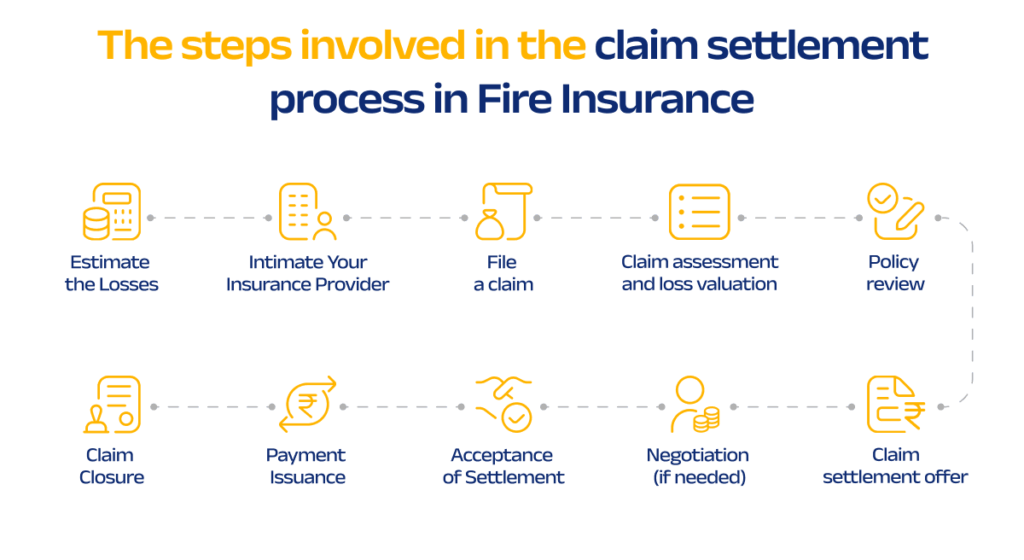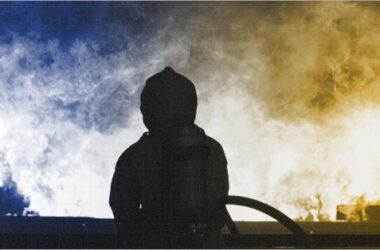In a world where the unexpected can happen at any moment, insurance serves as a safety net, providing a sense of security and protection against unforeseen calamities. Among the different forms of insurance available, Fire Insurance holds a critical place, safeguarding individuals and businesses from the devastating consequences of fire-related disasters. While it is reassuring to know that such insurance exists, understanding the intricacies of the claim settlement process is equally essential.
The path to recovery after a fire incident can be daunting, but the claim settlement process is ideally designed to ease the burden and help policyholders rebuild their lives. In this comprehensive article, we will look into the world of Fire Insurance, shedding light on the intricacies of the claim settlement process. Whether you are a policyholder seeking clarity on your rights and responsibilities or simply curious about how Fire Insurance works, this article aims to provide you with a clear, concise, and informative guide.
The Steps Involved in the Claim Settlement Process in Fire Insurance
The claim settlement process in Fire Insurance involves several crucial steps. If you have Fire Insurance and need to file a claim, the simple steps outlined below will help you settle your claim quickly.

1. Estimate the Losses
It is critical to assess the overall loss in order to be properly reimbursed. Try to keep track of all the losses sustained as a result of the incident. While doing so, make sure that
· The burnt goods should not be discarded.
· It is not necessary to rebuild or repair the damaged infrastructure.
· Keep proper evidence of the damaged or lost items.
2. Intimate Your Insurance Provider
The first step is to contact your insurance company or agent as soon as the fire incident occurs. You can either call their toll-free number or write to them to inform them about the loss. Promptly reporting the incident is essential, as most policies have a time limit for filing claims.
3. File a claim
You will need to fill out a claims form provided by your insurer. This form typically includes details about the incident, such as the date, time, and location, and a description of the damage, loss, or any related injuries. You may also be required to provide supporting documents like the police report or FIR (if any) and photographs of the damage. You must lodge the claim form within a stipulated time frame ( usually within 15 days) of the fire incident, to claim compensation. A delay in the submission of the claim form may lead to non-acceptance of the claim.
4. Claim assessment and loss valuation
After receiving your claim, the insurance company will assign a surveyor to assess the extent of the damage. The surveyor will visit the scene of the fire to evaluate the loss and determine whether it is covered under your policy. The surveyor will assess the value of the loss or damage, taking into account factors like the cost of repairs or replacement, depreciation, and any applicable deductibles. He will work with you to compile a list of items or property affected by the fire. Present all original documents and evidence needed for the surveyor’s loss assessment. Please provide every pertinent information as well as your full participation! You should retain a copy of the original reports of the investigation or associated documents for future reference.
The claim will be estimated by the insurer on the basis of the surveyor’s report. The objective of the insurance company here is to investigate the circumstances surrounding the fire to ensure there was no foul play or insurance fraud involved. They will try to gather evidence and documentation that may support your claim.
5. Policy review
The insurance company will review your policy to determine the coverage limits, deductibles, and any applicable endorsements or exclusions that may impact your claim
6. Claim settlement offer
Once the above steps are complete, the insurance company will provide you with a claim settlement offer. This offer outlines the amount they are willing to pay to cover the losses, minus any applicable deductibles or depreciation.
7. Negotiation (if needed)
If you believe the settlement offer is insufficient or if there are disagreements about the coverage, you may enter into negotiations with the insurance company. It’s crucial to provide proper evidence and documentation to support your claims further here.
8. Acceptance of Settlement
If both parties agree on the settlement amount, you can accept it. Once you accept the offer, the insurance company will proceed with issuing the payment.
9. Payment Issuance
The insurance company will issue a payment, typically in the form of a check, to cover the approved claim amount. This payment can be used to repair or replace the damaged property or cover other eligible expenses.
10. Claim Closure
After you receive the payment and use it to address the losses, the claim will be officially closed. Make sure to keep records of all transactions related to the claim for your records.
It’s important to note that the details of the claim settlement process mentioned above are indicative only and may vary depending on your insurance company, policy terms, and the nature of the fire incident. Hence, it’s always advisable to consult with your insurance agent or company for guidance and clarification throughout the process.
Conclusion:
Navigating the claim settlement process in Fire Insurance may seem like a daunting journey, but armed with knowledge and understanding, it becomes a path toward recovery and renewal. As we conclude our exploration into the intricacies of Fire Insurance, we hope to have illuminated the steps involved in this critical process, empowering you to face unexpected fire-related disasters with confidence. A direct broker will hand-held and guide you throughout the claim settlement process.
Remember that each step in the claim settlement process serves a purpose. These steps are designed to ensure a fair and equitable resolution, one that allows policyholders to regain their footing after the devastation of fire.
Furthermore, it is crucial to maintain open and transparent communication with your insurance provider throughout the process. Your insurance company is a partner in your recovery journey, and their expertise can be invaluable in helping you understand the terms of your policy and the nuances of your claim. By demystifying the claim settlement process, we hope to have provided clarity and assurance to those who rely on this essential safeguard. With the knowledge gained here, you are better prepared to face the unexpected
Frequently Asked Questions (FAQ)
1. What are the documents required for filing a Fire Insurance claim?
To be able to claim Fire Insurance in India, the following documents must be provided:
• A properly authorized copy of the insurance policy, including the schedule and endorsements
• Completed claim form
• Any newspaper clippings about the incident, if any
• Photographic evidence related to the fire incident
• Documents related to any previous experience
Additional Documents required:
- Committee report, if constituted for investigating the cause of the fire
- Fire brigade report about the fire incident (if required)
- Duly authorized FIR/Letter of Intimation to the concerned police station
- Final Investigation Report
- Forensic reports
2. Who should purchase STFI Coverage in Fire Insurance?
STFI is an acronym for “Storm, Tempest, Flood, and Inundation.” Business owners and operators of commercial properties, offices, factories, or warehouses may require STFI coverage as part of their Fire Insurance coverage. This coverage protects their assets and operations from potential storm, tempest, flood, or inundation damage. In essence, any business that requires protection from natural disasters should include STFI coverage in addition to its basic SFSP policy.
For the same reason, developers and builders working on building projects may also want STFI coverage to protect their properties while the buildings are being developed. It protects against probable storm, tempest, flood, or inundation damage during the construction stage. Similarly, public institutions including schools, Government offices, hospitals, and non-profit organisations may choose to include STFI in their Fire Insurance coverages.
3. What is the principle of proximate cause in Fire Insurance?
In Fire Insurance, the principle of “proximate cause” is an essential concept that helps evaluate whether a damage or loss is covered by the insurance policy. It involves figuring out whether the main or most immediate cause of an occurrence or loss comes within the purview of coverage. It assists in assessing how the damage or loss occurred and whether or not it was caused by an insured peril. At times, when an insured peril is succeeded by an uninsured peril, an insured peril succeeds an uninsured peril, or both occur together, the situation may become a touch complicated. The proximate cause principle facilitates the resolution of such situations by enabling the insurer to decide whether or not a claim is payable and, if so, to what extent.
4. What is Fire Insurance for Shop?
This is a type of insurance coverage that is designed primarily to protect businesses, notably retail stores, from financial damages caused by fire-related calamities. It provides monetary reimbursement for fire-related damage to the shop’s structure, equipment, inventory, and other covered assets.
Fire Insurance for shops is essential because fires can happen at any time and have disastrous repercussions for businesses. A fire can have a devastating financial impact, often leading to the closure of the shop. Shop owners may limit these risks and make sure they have the financial support they need to recuperate and reestablish their business if they have a proper Fire Insurance Policy in place.
Read more about Fire Loss of Profit Insurance







